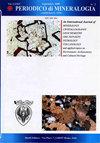Mineralogy and elemental composition of urinary stones: a preliminary study in northwest of Iran
IF 1.2
4区 地球科学
Q3 GEOCHEMISTRY & GEOPHYSICS
引用次数: 2
Abstract
The Formation of Urinary Calculi [or Kidney stones (renal lithiasis, nephrolithiasis)] is a serious disease among Iran’s population, inasmuch as renal stone prevalence rate is annually about 145 cases per 100000 men and women. In this study, the mineralogy and elemental composition of urinary stones were studied in East Azerbaijan province, located in northwest of Iran. X-ray diffraction (XRD), X-ray fluorescence (XRF) and atomic absorption spectroscopy (AAS) analyses were used to investigate the mineralogy of different types of Urinary Calculi. The results showed that the collected Urinary Calculi samples can be divided into four groups, based on their mineralogical aspect: mono-hydrated calcium oxalate, di-hydrated calcium oxalate, uric acid and urate/calcium oxalate/cystine, in which whewellite and uricite were the most abundant mineral phases. The oxalate stone types were characterized by the high concentrations of zinc, phosphorus and magnesium. Common minerals in the studied renal stones indicated that calcium oxalate urinary stones have a similar prevalence ratio as in Middle East countries. However, urate compounds were significantly higher in Iran compared to other countries; The niahite mineral was not found in studied samples. In the cities having very hard and hard drinking water, uric acid and oxalate type stone were the main phases in East Azerbaijan province with Mediterranean climate, urate urinary stones were dominant. XRF results indicated that the frequency of Ca was from 0.11 to 25.63%, which has the highest concentration among other elements. The strong positive correlation between Ca and P indicated that calcium tends to be participated in the structure of phosphorus–bearing urinary stones.伊朗西北部尿路结石的矿物学和元素组成的初步研究
尿路结石[或肾结石(肾石症,肾结石症)]的形成是伊朗人口中的一种严重疾病,因为肾结石的患病率每年约为每100000名男性和女性145例。在本研究中,研究了位于伊朗西北部的东阿塞拜疆省尿路结石的矿物学和元素组成。采用x射线衍射(XRD)、x射线荧光(XRF)和原子吸收光谱(AAS)对不同类型尿路结石的矿物学进行了研究。结果表明:收集到的尿路结石按矿物学特征可分为单水合草酸钙、双水合草酸钙、尿酸和尿酸/草酸钙/胱氨酸4组,其中轮辉石和尿酸石是含量最多的矿物相。草酸盐型石质具有高锌、高磷、高镁的特征。肾结石中的常见矿物质表明,草酸钙尿路结石的患病率与中东国家相似。然而,与其他国家相比,伊朗的尿酸化合物明显更高;在所研究的样品中未发现铌铁矿。在地中海气候的东阿塞拜疆省,非常硬和硬饮用水的城市,尿酸型和草酸型结石是主要阶段,尿酸型尿路结石占主导地位。XRF结果表明,Ca的频率在0.11% ~ 25.63%之间,是其他元素中浓度最高的。Ca和P呈强正相关,说明钙倾向于参与含磷尿路结石的结构。
本文章由计算机程序翻译,如有差异,请以英文原文为准。
求助全文
约1分钟内获得全文
求助全文
来源期刊

Periodico Di Mineralogia
地学-地球化学与地球物理
CiteScore
1.50
自引率
14.30%
发文量
0
审稿时长
>12 weeks
期刊介绍:
Periodico di Mineralogia is an international peer-reviewed Open Access journal publishing Research Articles, Letters and Reviews in Mineralogy, Crystallography, Geochemistry, Ore Deposits, Petrology, Volcanology and applied topics on Environment, Archaeometry and Cultural Heritage. The journal aims at encouraging scientists to publish their experimental and theoretical results in as much detail as possible. Accordingly, there is no restriction on article length. Additional data may be hosted on the web sites as Supplementary Information. The journal does not have article submission and processing charges. Colour is free of charges both on line and printed and no Open Access fees are requested. Short publication time is assured.
Periodico di Mineralogia is property of Sapienza Università di Roma and is published, both online and printed, three times a year.
 求助内容:
求助内容: 应助结果提醒方式:
应助结果提醒方式:


